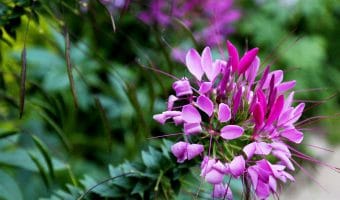
Lest you think all I do is whine about the heat, let me say that this is a fine season for harvesting and saving seeds. Extended weeks of high temperature and little rain have encouraged early seed set in many plants. The absence of rain has also meant fewer fungus spores to infect and ruin seeds before they can be harvested.
To successfully preserve themselves, seeds must cure in a dry environment while still on the flowerhead; they need to dry down to a maximum 12 per cent moisture content, preferably lower. In rainy summers with lower temperatures, many seeds become infected with fungus spores. You might be able to see the dark, powdery stains of fungus growth when you harvest the seeds, or it can show up later when you plant them. Needless to say, this can be a big disappointment when you’ve saved seeds from a special plant.
I save seeds from plants that are particularly interesting to have more for myself and to share with friends. Some seeds are saved for sentimental reasons, because they’re family heirloom plants. Others are saved because they’re terrific plants and hard to find for purchase. In the 1970s I grew tall ‘Man in the Moon’ marigolds, with creamy carnation-like flowers, and sadly they’ve disappeared from commerce. I grew them for several summers, and wish I had saved seeds from them. But of course, saving seeds from hybrid plants doesn’t guarantee identical seedlings; often hybrid seeds don’t come true, and what you get is an ancestor.
However, sometimes hybrid seed is stable, as is the case with my self-sown ‘Purple Queen’ cleomes. This summer annual spills its seed every year, and then reappears the following summer with identical flowers. This has been going on for several years and still the seed is true to the original plants. I’ve also seen this happen with calendula and cosmos that have lasted years by sowing themselves in the garden, then blooming with identical flower colours. Saved impatiens seed has been less dependable, coming true to the original colour for two or three years, then reverting to an ancestral deep pink. The author Thalassa Cruso referred to this colour as Garden of Eden pink, because so many hybrids eventually revert to that particular hue.
This week I carefully collected seeds from three ‘Biedermeier’ columbines (Aquilegia ‘Biedermeier’, Zone 4), which are resistant to columbine leaf miner. I have several kinds of columbine, and this is the only one that leaf miners don’t swarm to. ‘Biedermeier’ plants are occasionally found in garden centres, but not often enough to rely upon. I also took a few seeds (all that the cardinals left behind) from the Italian honeysuckle vine (Lonicera caprifolium, Zone 6). Now I’m watching for seeds from the willow gentian (Gentiana asclepiadea, Zone 6) that has flower buds not yet open, and I suspect these seeds will be more challenging to harvest.








